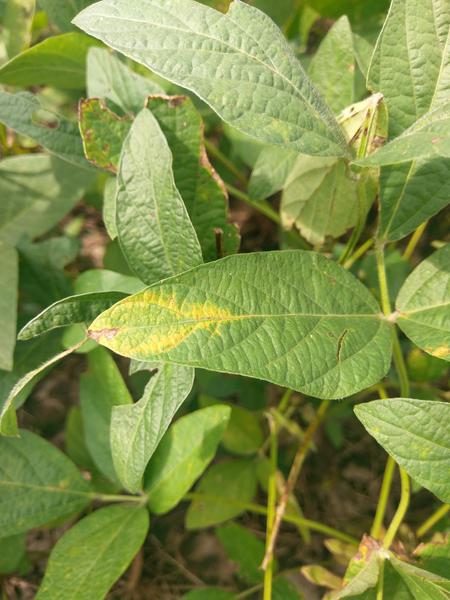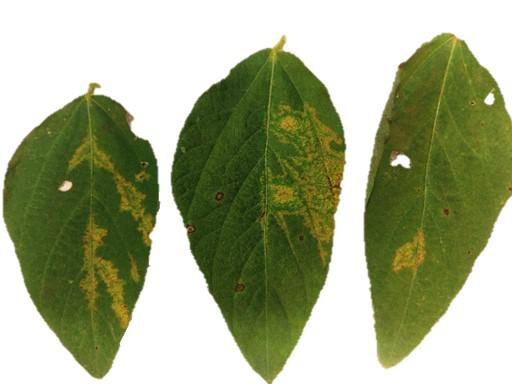Soybean Vein Necrosis Virus
- Type
- Disease
- Leaf Condition
- Tip Burn, Marginal Necrosis, Interveinal Necrosis, Complete Necrosis, Brittle, Leaf Spot
- Leaf Color
- Yellow, Orange Red, Bleached, Patchy Yellow And Brown Areas, Marginal Chlorosis, Interveinal Chlorosis
- Leaf Location
- Upper, Lower, Young, Mature
- Main Stem
- Necrotic Spots
- Petioles Condition
- Lesion, Death
- Field Distribution
- Random, Localized Area
- Prior Environmental
- Cool Cloudy
- Season
- Early Vegetative, Mid To Late Vegetative, Flowering, Pods Present
- Cropping System
- Soybean Followed By Soybean, Conventional Till, Reduced Till
Introduction
Soybean vein necrosis virus (SVNV) is a Tospovirus that is occasionally reported in North Carolina soybeans and, while it is not economically important in the region, has the potential to cause severe damage in individual soybean fields.
Pathogen
SVNV is caused by a Tospovirus, and this virus infects the whole plant and leads to necrotic tissue. SVNV is a vector-mediated pathogen spread by immature soybean thrips. Thrips acquire the virus from winter weeds and transmit the virus to soybean plants.
Symptoms
SVNV has symptoms that are similar to other soybean diseases such as brown spot, cercospora leaf blight, or herbicide damage. The similarity of SVNV to other disease symptoms makes this disease difficult to diagnose. Symptoms of the disease start as randomly distributed, irregular yellow spots ranging in size from ¼ to ½ inches along major leaf veins that progress to red-brown, necrotic lesions. Vein discoloration could be observed in plants infected with SVNV. Symptoms can occasionally be seen on the underside of leaves as well, with vein discoloration being the most common underside symptom. SVNV can be accurately diagnosed with laboratory assays and it is easier to diagnose SVNV with leaves in the early stage of the disease.Seed mottling may also occur; however, seed symptoms may be caused by other factors.
Management
Vector management for other soybean viruses has not been proven significant to control the spread of viruses, making this option unviable for management of SVNV. Currently, there are no economical management tools for SVNV.
Useful Links
The Soybean Research and Information Initiative has a useful printout that describes SVNV and how to distinguish it from other common soybean diseases.
The NC State University Plant Disease and Insect Clinic provides diagnostics and control recommendations.
The NC State Extension Plant Pathology portal provides information on crop disease management.
The North Carolina Agricultural Chemicals Manual provides pesticide information for common diseases of North Carolina. The manual recommendations do not replace those described on the pesticide label, and the label must be followed.
Acknowledgements
This factsheet was prepared by the NC State University Field Crops and Tobacco Pathology Lab in 2020.
- Check out our Facebook and our Twitter!




